Table of contents
Do you want to increase sales and build even better relationships with your customers?
Effectiveness hundreds of times higher than newsletter? Welcome to the world of the big data. This article shows what can be achieved by using a marketing automation system. React to customers’ behaviors in real time – such as viewed products or abandoned carts – and engage your clients. How to conduct effective marketing based on […]
Effectiveness hundreds of times higher than newsletter? Welcome to the world of the big data. This article shows what can be achieved by using a marketing automation system. React to customers’ behaviors in real time – such as viewed products or abandoned carts – and engage your clients.
How to conduct effective marketing based on the knowledge about customers?
The tools available to marketers are becoming more sophisticated. As a result, the customers are more satisfied, because instead of unsolicited mass e-mail, they receive messages that they may relate to and which are of interest to them. But in order to be able to customize your marketing message, you should use strategies based on customer knowledge. Therefore, you need a system to collect data about the store users, to respond to their actions in real time and, finally, to automate marketing communication. A system such as edrone.
Marketing communication with customers brings measurable benefits to an online shop, but one has to know how to conduct it. A common way used by online shops is to send a newsletter to customers in their database. It is a method which is proven and easy to implement. Unfortunately, it is not necessarily the most effective one. The problem Edrone aims to address is to find as effective ways of engaging customers as possible. To meet the needs of many e-commerce entities, we have decided to give our customers a wide repertoire of ready-made marketing scenarios.
The scenarios we have developed are called engagements. They are ready-made plans of e-mail communication sent to the shop’s customers. What is important, the effectiveness of these techniques has been tested by us. From among many ideas, we have chosen those which work best. We are continuously working on new ones as well. The current trend in marketing is to communicate with customers through personalized messages and to do it in an automated way at the same time. That is why in Edrone we introduce techniques which employ machine learning (I encourage you to read the article Product Recommendations – Deal with it!).
Image 1: An example of a personalized newsletter with product recommendations.
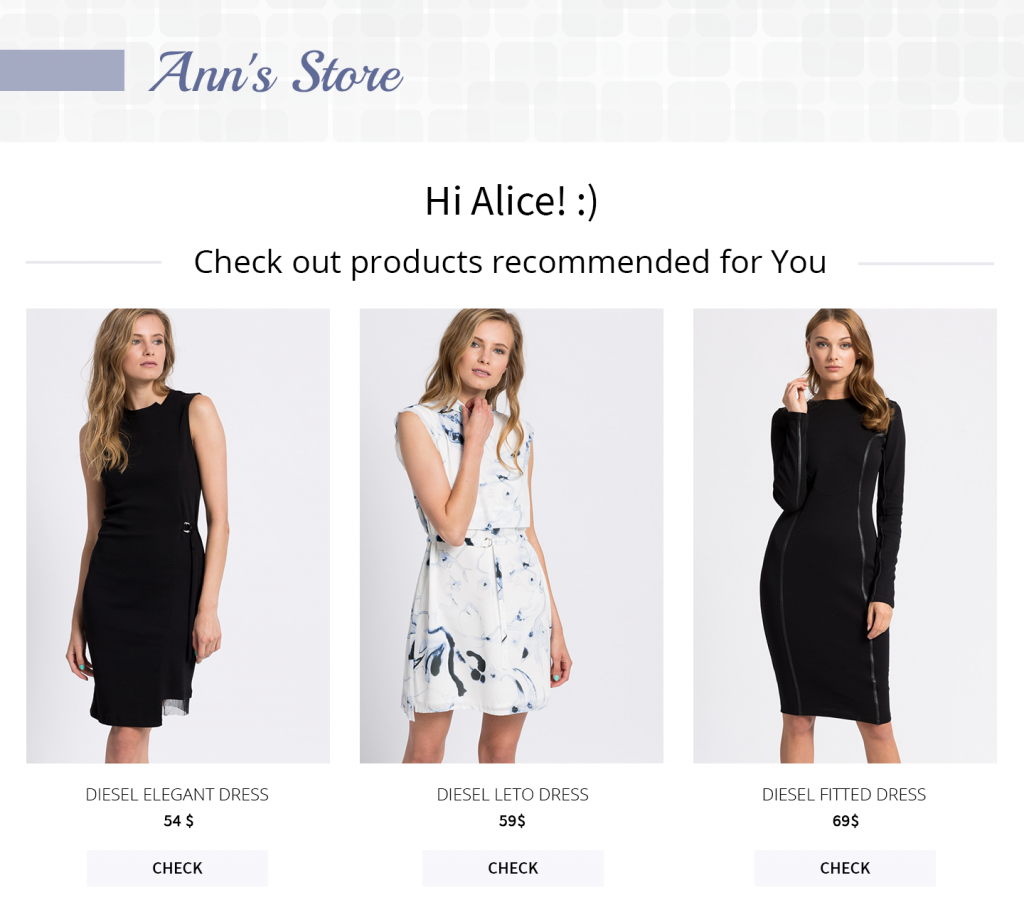
Serial e-mails and those based on the knowledge about the customer
In Edrone, we distinguish between two categories of engagements: marketing and behavioral. The difference between them is primarily due to the trigger, which initiates communication with customers and, to a lesser extent, due to adjusting the message to the target group. With edrone, even newsletters can be personalized and use behavioral elements.
In the case of marketing strategies, it is the marketer who designs the communication which will be sent to a specific target group (e.g. to all customers of our shop or to a defined group such as trendsetters or customers who spend the most). The information which the shop’s customers will receive is the same for everyone, the only difference being certain dynamic parts of an e-mail such as the language version. It is also the marketer who decides about the time of sending an e-mail. A classic newsletter is one of the techniques described. An example is a message of the following type: „Valentine’s Day Discount Voucher”. A more developed newsletter is an A/B newsletter. It makes it possible to test two versions of an e-mail which differ in, e.g. the layout, on a limited number of customers and send the better version to the other ones (I encourage you to read A/B Tests. How to Make it Reasonable?)
The second category is the so-called behavioral engagements. Their strength is that they are based on realistic actions of online shop’s users. They do not have a specific date on which they are to be sent. The trigger is a concrete action by the shop’s user. Behavioral engagements are also called transactional, since they are often connected with transactions performed by the shop’s customers.
Image 2: Example of a behavioral scenario Recover Abandoned Carts.
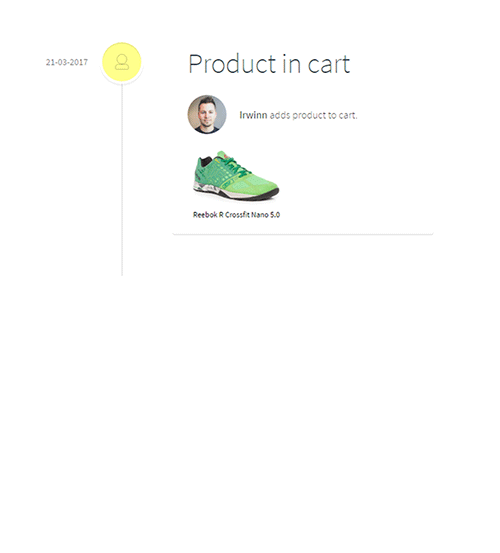
In the case of behavioral scenarios, an even greater part of communication (compared with marketing e-mails) is dynamic and personalized. An example of a behavioral strategy is the recovering of abandoned carts: Irwin visits our shop and adds a product to the cart. If he does not purchase anything, he will receive an e-mail after 3 hours asking him whether he would like to finalize the purchase or whether he is still interested in a given product. If he makes the purchase, he will get a discount.
Below, we present ready-made scenarios divided into the marketing and behavioral:
marketing engagements:
- Dynamic Newsletter – a classic newsletter improved with dynamic elements such as a placeholder with recently viewed products, bestsellers and one-off vouchers;
- Custom Newsletter – it is based on the Dynamic Newsletter engagement, but makes it possible to reach very specific groups of consumers;
- A/B Newsletter – dynamic newsletter with the function of testing e-mails before sending them to a larger number of customers;
behavioral engagements:
- Restore Customers – contact with the customer after a specific number of days since they last viewed products in the shop and did not make a purchase;
- Viewed Products – it is an extended version of the Restore Customers; the marketer can set as many as four different messages which will be sent to his shop’s customer, e.g. after 1/3/7/14 days;
- Transactional Cross-Selling – engaging customers based on the product categories they were interested in
- Recover Abandoned Carts – recovering an abandoned cart;
- After Sale – a message sent after a purchase;
- Loyalty Program – a message encouraging to another purchase; after exceeding a set threshold of money spent in the shop, the customer receives a discount voucher;
- Newsletter Subscription – a user leaves their e-mail address in response to a pop-up on the shop’s website or in an embedded field for entering e-mail address on the shop’s website; as a reply, they will receive two e-mails – the first one with a request to confirm e-mail address and a second one thanking them for signing up for the newsletter.
- Recommendations – suggesting customers the products they might be interested in. Recommendations are made on the basis of the products bought by other users.
Obraz 3: Engagements to choose in Mission Control Panel.
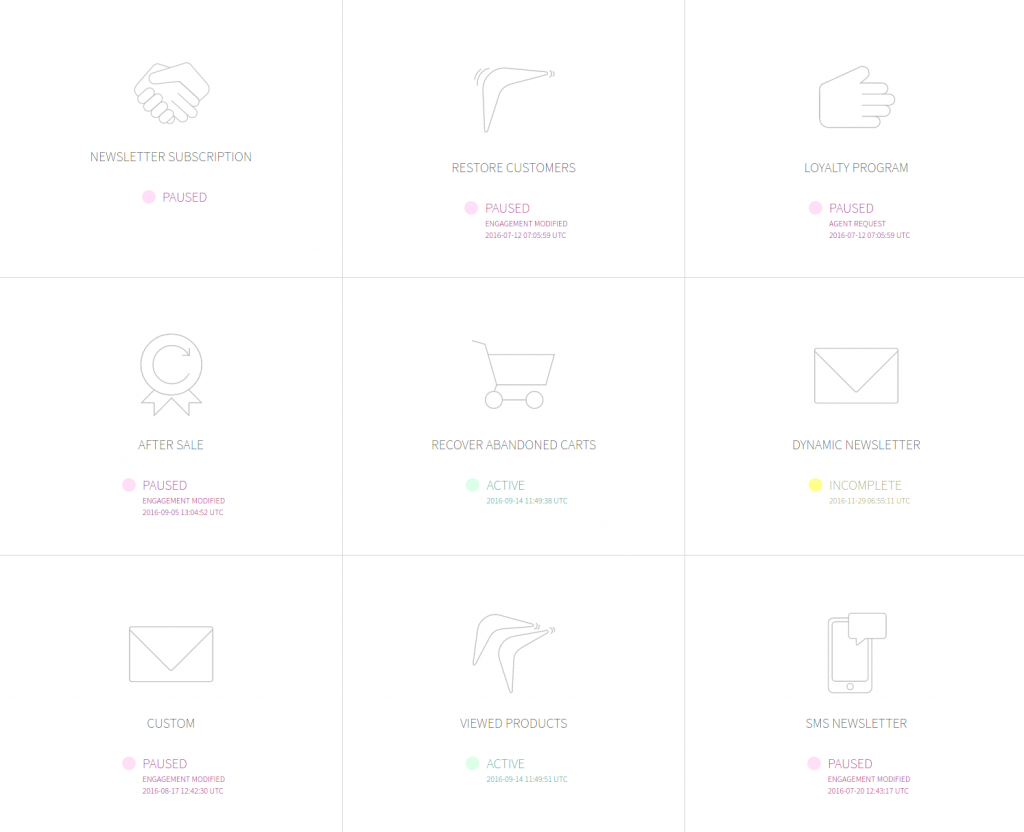
Transactional Cross-Selling is the most effective. It is the latest script and basically „crushes” other engagements. It provides the ability to define communication-based on the category of products that the customer has viewed, added to the cart, or purchased. Transactional Cross-Selling is most commonly associated with Recommendations, thanks to the dynamic placeholder system, available while drafting messages. You can add dynamic elements to each message you create in edrone, which will include personalized products for the specific customer, particularly product recommendations.
The Transactional Cross-Selling scenario does not give much way to the After Sale scenario. The effectiveness of this engagement is not surprising – if the customer has made a purchase and is happy with it, there is a good chance that they will make another one. The Dedicated Newsletter took the third place. Its high-efficiency results from the possibility of reaching very specific target groups, e.g. customers who responded positively to marketing campaigns in the past. Just behind the Dedicated Newsletter is the Abandoned Carts – its strength can be explained in a similar way as After Sale.
Interestingly, next in the order is Newsletter Subscription – as you can see, even a welcome message can win you clients. Restore customers, Newsletter A/B and Recommendations show average performance. In turn, the lowest in the list is the Dynamic Newsletter, which is over 400 times less effective than Transactional Cross-Selling (sic!). Does this mean that we should not use the Dynamic Newsletter? Not necessarily, but if we can decide, it is better to use the A/B Newsletter or the Dedicated Newsletter (which allows responding accurately to customer needs with a little more work on the part of the marketer).
Chart 1. The value of products sold per one email (data 09.2016 – 03.2017)
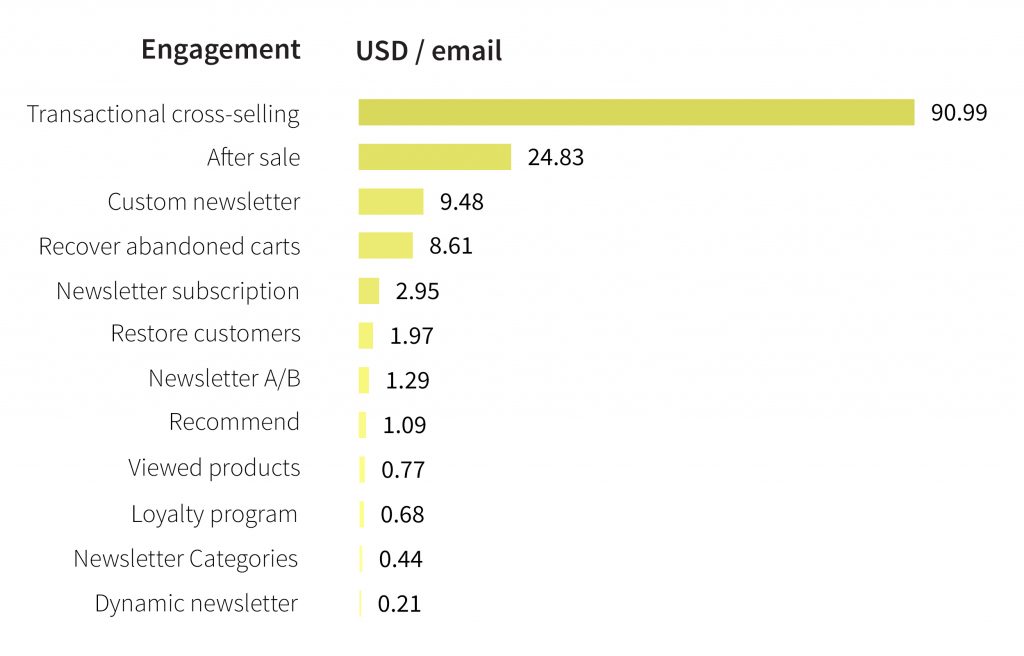
To have a full picture, let us also look at the value of products sold per engagement (see: Chart 2). The Dynamic Newsletter brings the biggest benefits to online stores. The value of the products sold in this engagement represents 50% of the amount generated by edrone. Such a large value may seem paradoxical if you remember that the Dynamic Newsletter brings the least money per one email sent. In this case, the scale effect – the Dynamic Newsletter is often sent to all customers registered in the e-store database. In this case, quantity turns to quality – at least in revenue. After Sale, which in the previous graph occupied second place, has again taken 2nd place. This shows how important recurring customers are. A high value of the products sold is also achieved through engagements that involve restoring clients after they had abandoned carts or viewed products (Abandoned Carts, Transactional Cross-Selling, Restore Customers and Viewed Products, Recommend). They account for almost 1/4 of the value of all products sold. High revenue comes from „smart” newsletters (Newsletter A/B and Dedicated Newsletter).
Chart 2. Total value of products „sold” by a certain engagement (data 09.2016 – 03.2017)
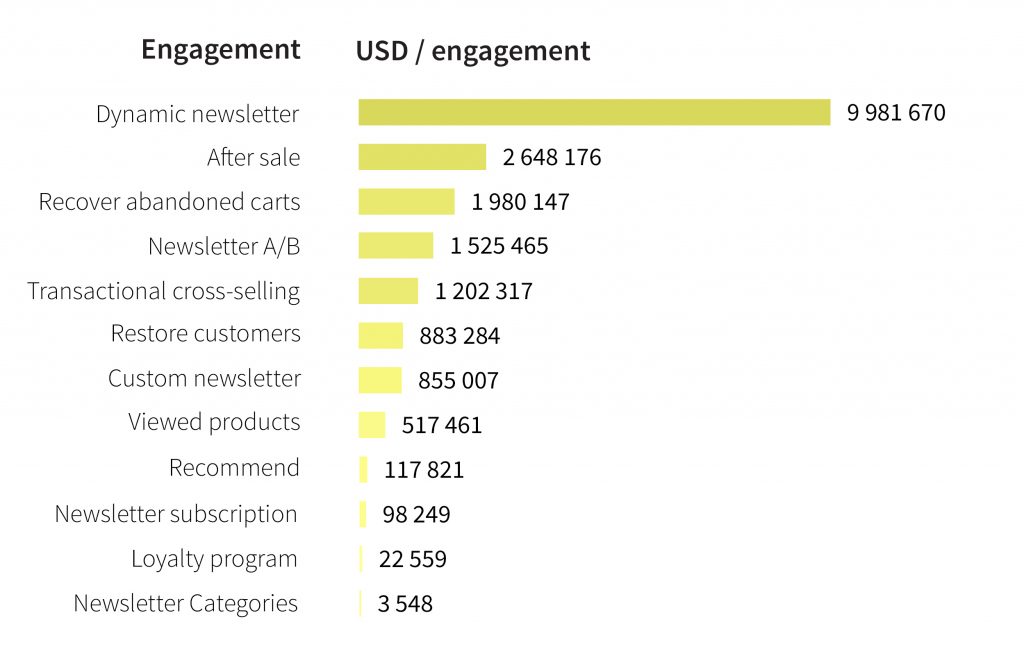
Sniper rifle or a cannon?
Time for conclusions. Personalized communication with customers is much more effective than mass mailing. Even if we send a regular Dynamic newsletter, we can do it much more effectively by addressing a specific customer segment or using A/B testing. The key is to have knowledge of the customer – which we can get through edrone – and the ability to use it. While the Dynamic newsletter brings real money to business, an idea as simple as A/B Testing increases its effectiveness (measured as revenue per e-mail).
The winner of the ranking confirms the advantage of behavioral approach over mass approach. Transactional Cross-Selling came out best of all engagements in terms of the value of products sold per e-mail! In this respect, it is clearly better even than After Sale.
Of course, behavioral and marketing scenarios are complementary. Since the combined Dynamic Newsletter, Newsletter A/B, Dedicated Newsletter and Newsletter Categories have generated 60% of revenue, it can be seen that they simply cannot be abandoned. Using some of them is one thing, using other is another. Behavioral engagements can be compared to a fishing rod, at the end of which the bait is aimed at a specific customer. Newsletters, on the other hand, are a fishing net, notably with a rather big mesh, but one that a marketer can throw at all their customers.
Is transactional marketing with edrone a good investment?
Let’s have a look at the case of eButik.pl. eButik.pl is the largest online store in Poland and Central and Eastern Europe, bringing together fashion brands from economy class. The eButik.pl domain currently has over 1 million unique users monthly.
In the first week of using edrone, they launched three scenarios for marketing automation: Abandoned cart recovery, Loyalty program and Reminders of the products viewed. The sender of the messages was a famous model, Safah Farray. If a client e.g. had added some products to the cart without finishing the transaction, she received a personalized message in which Sarah offered her to finish the shopping with a possibility of a free return.
Transactional scenarios turned out to be incredibly successful. In the second week of launching edrone the purchases made through email channel were worth approx. $60 750 in total. CTOR hit 55%, which means that over half of the opened messages has been clicked. Even though only 22% of users visiting the shop were returning customers, orders they’ve made were worth almost 50% of the shop’s transactions. The investment in restoring customers with edrone was profitable for the store. Return of investment equaled 96%, while in case of acquiring new clients through Google Adwords company experienced 8% loss.
I believe that this article and case study is a proof good enough for you to implement transactional marketing in your online store. Finally, it is worth pointing out that in edrone even marketing scenarios have the potential for greater flexibility in adding components based on customer behavior. Nothing prevents you from placing in the newsletter e.g. an item with photos of products the customer had recently viewed. This way, the boundary between marketing and behavior is blurred.
edrone
CRM, Marketing Automation and Voice Commerce for online stores. All in one.
Do you want to increase sales and build even better relationships with your customers?